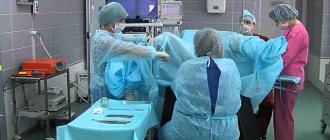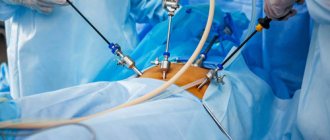Laparoscopic operations
Laparoscopic surgery is a modern minimally invasive method in gynecological treatment in Chelyabinsk and is a gentle type of surgery
Advantages of laparoscopy:
- surgical intervention is carried out not using a cavity incision, but by a puncture method, which significantly reduces the rehabilitation process and the risk of infection
- minimally invasive surgery allows you to preserve female organs and reproductive function
Indications for laparoscopic intervention:
- formations on the ovaries (cysts, tumors)
- fibroids (tumor) of the uterus
- tubal infertility (restoration of tubal patency, removal of compromised fallopian tubes in preparation for in vitro fertilization)
- various forms of endometriosis
- tubal (ectopic) pregnancy
- prolapse and prolapse of the walls of the vagina and uterus
- tubal ligation (sterilization)
- pathology of the development of the genitourinary system
- early diagnosis of malignant tumors
Carefully selected anesthesia and low-invasiveness of the operation allow the woman to return to everyday life within a couple of days.
Medical specialists have extensive experience in performing laparoscopic operations of varying levels of complexity. The use of laparoscopy in the treatment and diagnosis of female diseases is carried out in compliance with modern medical standards.
Laparoscopic surgery
Multidisciplinary endosurgical center of expert level
The endosurgery department of the DKB is perhaps the only one of its kind in our region.
We employ specialists of the highest level - surgeons, gynecologists, urologists, coloproctologists, plastic surgeons. We perform a wide range of gentle laparoscopic surgical interventions, many of which are unique and are performed only here. The department is equipped with expert-level medical equipment; high-tech consumables from the world's leading manufacturers are used, wherever possible, disposable. We understand that any surgery is stressful, so we make every effort to ensure your comfort. You can consult with a surgeon whose experience you trust. A consultation with our specialists is organized especially for you in the evenings, on weekends, as well as online consultations if you live outside of Samara.
Laparoscopic surgery without large incisions is a reality!
It is no secret that endosurgical (or laparoscopic) operations have seriously displaced traditional surgery through incisions. Low trauma and short hospital stay for the patient, quick recovery after surgery, minimal pain, and absence of postoperative scars are just a small part of the advantages of endosurgery. Endoscopic surgery is the most advanced, most actively developing area of modern surgery.
Today, laparoscopic operations are used in abdominal surgery, gynecology, urology, thoracic surgery, and oncology.
What are the main advantages of laparoscopy?
The first and most obvious is the absence of a large abdominal incision. Instead, small punctures from 5 to 12 mm are made. The very dissection of the anterior abdominal wall during traditional surgery is already a major trauma for the body and a potential threat of postoperative complications (suppuration, seromas and hematomas, failure of the postoperative scar and, as a consequence, postoperative hernias).
During an open operation, internal organs are “dried out” and injured by napkins and the surgeon’s hands, which also has a bad effect on recovery time and can lead to adhesions and pain. Of course, with laparoscopic surgery the impact on internal organs is much less.
Well, don’t forget about aesthetics! Even the smallest and neatest postoperative suture turns into a pronounced scar - such are the characteristics of our body. Yes, modern cosmetology can help make it less noticeable, but still, it will remain with you for life. Traces after laparoscopy are practically invisible - NOTES technologies allow the intervention to be performed through a puncture in the navel or even through the natural openings of the body.
So, laparoscopy reduces surgical trauma, reduces the severity and duration of postoperative pain, and reduces the number of complications. At the same time, the quality of the intervention on internal organs is not inferior to open operations due to the use of modern medical equipment.
Laparoscopic operations have been successfully performed in the Children's Clinical Hospital for a long time; an increasing number of patients choose them instead of open surgery.
Seeing such popularity of endosurgical treatment methods, we allocated a separate two-story building for them, completely remodeled it, purchased state-of-the-art equipment from leading global manufacturers and invited the best specialists!
Transvaginal operations
Transvaginal (vaginal) surgeries are performed through the vagina. Recommendations for the use of such surgical intervention are extensive:
- uterine fibroids
- internal endometriosis
- aesthetic elimination of cervical deformity
- formations on the ovaries and vagina
- prolapse or prolapse of the walls of the vagina, uterus
- surgical removal of organs
- various inflammations and abnormalities
However, with a large list of gynecological diseases, the main condition for carrying out planned vaginal operations must be met - the absence of an inflammatory process of the genital organs.
Transvaginal operations have a number of obvious advantages:
- lowest risk of postoperative complications
- no scars
- minimal blood loss
- rapid recovery of a woman's physical activity
Contraindications for laparoscopy.
Contraindications for any procedure can be absolute or relative. Absolute refers to those indications in which performance is strictly prohibited. Relative contraindications are those in which the procedure is possible, but one should prepare for complications.
For laparoscopy, absolute contraindications are only terminal conditions of the patient, namely coma, agony, as well as sepsis or purulent peritonitis.
Relative contraindications for laparoscopy may include late pregnancy, recent surgical interventions, problems with blood clotting, and a fairly high degree of obesity.
Back to section
Hysteroscopy and hysteroresectoscopy
Minimally invasive interventions also include hysteroscopy. The essence of the method is that endoscopic equipment is introduced into the uterine cavity - a probe with LEDs and a video camera. Hysteroresectoscopy (a type of hysteroscopy using a resectoscope) is used to remove pathological formations.
Medical procedures during hysteroscopy:
- examination of the mucous membrane to make a diagnosis
- separate diagnostic curettage of the uterine cavity and cervical canal (RDV) in order to obtain material for the study of various pathological formations (endometrial diseases)
The following diseases may be indications for hysteroscopy:
- submucous fibroid
- malignant formations
- endometrial polyp
- endometrial hyperplasia
- residues in the cavity of the fetal membranes (after birth)
- unstable menstrual cycle
- bleeding of unknown etiology
- miscarriages or infertility
- uterine anomaly
At the Medical Center, the procedure is performed using a bipolar resectoscope (“Karl Storz”). Today this is the most modern device for intrauterine surgery.
For women with various inflammations and symptoms of diseases, all surgical interventions are prescribed only by the attending physician.
Contraindications for hysteroscopy are inflammatory processes in the acute stage. Therefore, it is very important to properly undergo preoperative preparation before hospitalization in order to avoid complications in the future.
Preoperative preparation at Medical takes a minimum of time. At the preparatory stage, a series of general clinical examinations are required, which the patient can undergo in our clinic within 1-2 days.
After hysteroscopy, the patient is observed for 2-3 hours, rests from anesthesia and goes home during the day. If necessary, sick leave is issued. After two or three days, the patient comes to extend or close her sick leave. Further treatment is prescribed based on analyzes of the collected biomaterial (prepared for 10-14 days).
Surgical gynecological interventions take place along with rehabilitation measures. This reduces the patient’s rehabilitation period and the risk of postoperative complications.
Colonoscopy in private clinics
Registration for the procedure is made by phone or online at a time convenient for the patient. Moreover, many clinics are open on weekends and holidays.
The examination is performed on imported colonoscopes by specialists who are certified to perform this type of manipulation.
Since the colonoscopy procedure is associated with unpleasant sensations and often pain, the patient is given pain relief with sedation (light sleep under the influence of a tranquilizer) or general anesthesia, if desired.
Instruments and consumables used during colonoscopy are disposable or sterilized according to international standards.
Laparoscopy of ovaries and fallopian tubes
Using the example of laparoscopy for polycystic ovary syndrome and surgery on the fallopian tubes, we will consider in more detail the procedure for providing the service and the price range.
After diagnosing ovarian cysts, the doctor individually decides on the treatment tactics for the patient. If the disease cannot be treated with medication, laparoscopy of the ovarian cyst or fallopian tubes is prescribed.
The patient needs to be prepared before surgery:
- Perform a series of laboratory tests of blood and urine, including tumor markers.
- Carry out bowel cleansing before surgery according to all the rules of surgical preparation.
- Organize elastic bandaging of the lower extremities to prevent thromboembolism.
- Warn the patient not to eat or drink on the day of surgery. Since laparoscopy is performed under general anesthesia, an empty stomach is a necessary requirement to avoid aspiration of vomit.
What is the advantage of laparoscopy over conventional abdominal surgery?
- the risk of developing adhesions is much lower;
- there are no complications in the form of abdominal wall hernias;
- quick recovery period after surgery;
- use of lower doses of anesthetic drugs.
In some cases, laparoscopy is contraindicated
However, laparoscopy is not always possible. The procedure has contraindications:
- Severe infectious diseases with impaired general condition.
- Diseases of the heart and blood vessels in the stage of decompensation.
- Acute cerebrovascular accidents.
- Adhesive process in the abdominal cavity.
- A condition accompanied by swelling of the intestinal loops.
- A purulent process in the abdominal cavity, covering most of the peritoneum.
- Shock conditions associated with severe blood loss.
- Cancer processes in ovarian tissues.
- Intra-abdominal bleeding.
- A large tumor in the ovary or fallopian tube.
- Abdominal surgery performed less than six months ago.
- Disorders of the blood coagulation system.
- Severe obesity.
Some contraindications are relative. In each individual case, the decision to perform an operation is decided by the doctor, taking into account the balance of benefits and possible complications.
Price for the service within the Russian Federation
Prices for laparoscopy vary depending on the level of the clinic
How much does ovarian and fallopian tube laparoscopy cost? The cost of surgery in different medical institutions can vary significantly.
For example, the average cost of a service in commercial organizations consists of the price of pain relief, the procedure itself, hospital stay (the cost of the room per day is paid), food and additional services.
On average in Moscow and the Moscow region, such a service costs from 23 to 120 thousand rubles. In regions, prices may be slightly lower. For example, in Novosibirsk such a service can cost from 12 thousand rubles, in Arkhangelsk - from 22 thousand rubles, in Krasnodar - from 15 thousand rubles.
Cost of services in foreign clinics
The cost of gynecological laparoscopy abroad varies depending on the country, the time the patient spends in the clinic and the complexity of the operation. It is believed that gynecological laparoscopy is most expensive in the United States. In second place are Israel and the countries of the European Union. Asian clinics offer the lowest prices for services among foreign ones. The cost of the procedure directly depends on the status of the medical institution, the comfort of the room, and the qualifications of the consulting and operating doctor. The highest prices for medical services are recorded in clinics at universities and research centers. Most likely, this is due to the fact that the medical staff in such institutions are highly qualified and have scientific titles.
As a rule, the service provided by foreign clinics includes diagnostic procedures, preparing the patient for surgery, surgery, recovery in the early postoperative period and rehabilitation.
In foreign clinics you will have to pay a large sum of money for laparoscopy
Approximately how long can ovarian or fallopian tube laparoscopy cost abroad?
According to Internet resources, the cost of laparoscopic diagnostics in the USA is over $2,000, and operative diagnostics – $10,000 or more. In Germany, a diagnostic procedure costs about $1000-1500, a surgical procedure costs up to $8000, in Israel diagnostics costs up to $1500, and laparoscopy surgery costs over $4500. In Asian countries, this service costs on average 2 times cheaper than in Germany.
As can be seen from the review of the cost of laparoscopic procedures, Russian clinics offer the lowest prices. In addition, by choosing treatment in Russia, the patient significantly saves on transportation costs. A flight to the USA and back will cost almost a third of the cost of the treatment itself at the clinic.











